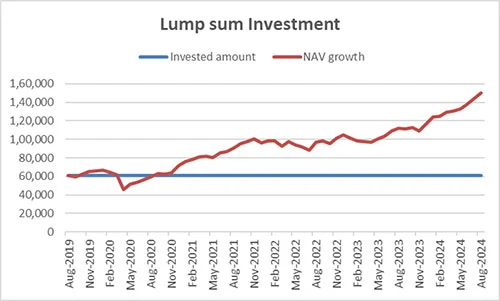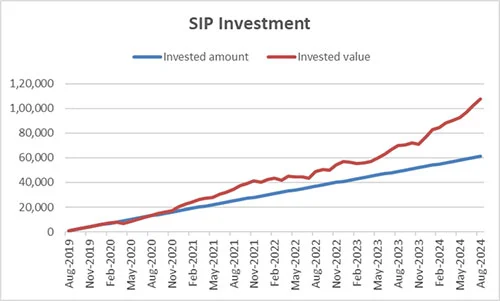XIRR vs CAGR in Mutual Funds: Which is the Better Tool to Evaluate Returns?
Divya Grover
Aug 05, 2024 / Reading Time: Approx. 10 mins
Listen to XIRR vs CAGR in Mutual Funds: Which is the Better Tool to Evaluate Returns?
00:00
00:00
Mutual fund investments play an important role in helping investors realise their key financial obbjectives. While many experts recommend an 'invest-and-forget' approach to mutual funds, it is essential to review the holdings at regular intervals to ensure that they are meeting your expectations and are on track to meet your financial goals. Mutual fund return is a crucial factor that helps you evaluate its performance. It also helps you to determine whether there is any need for portfolio actions such as switching to a better-performing fund or increasing investments in the current scheme/s.
Mutual fund returns can often be a bit complex to understand, but once you understand the basics it will enable you to make informed investment decisions.
In this article learn about the two commonly used types of mutual fund returns - CAGR and XIRR - their meaning, significance in the evaluation of a scheme's performance, differentiating points, and when you should use them.
1. What is CAGR - Compounded Annual Growth Rate?
The Compounded Annual Growth Rate (CAGR) is the most common mutual fund returns used when determining a fund's performance.
It is the cumulative average annualised returns of investments. In other words, it shows a fund's average annual growth or decline over a specific time period. CAGR is particularly useful for calculating returns in the case of single investments, such as in the case of a one time lump sum investment in a mutual fund scheme, without any additional contributions.
CAGR is relatively simple to calculate as it only considers the beginning and the end value of the investment along with the time period.
CAGR is calculated as:
CAGR = (End Value of Investment /Initial Value of Investment) ^ 1/n - 1
(where n = number of years of investment)
Let us assume that an investor invests Rs. 1 lakh in a mutual fund scheme on January 1, 2019. By January 2024 the value of this investment grew to Rs. 1.6 lakh.
So, Beginning Value = Rs. 1 lakh
End/final Value = Rs. 1.6 lakh
n = 5 years
By applying the CAGR formula the growth rate of the investment would work out to nearly 10%. In other words, the investment grew at an average annual rate of 10% over the 5 years, showing how much your money increased each year on an average. Thus, CAGR works best for interpreting point-to-point returns.
CAGR calculation
| Year |
Investment Value |
Annual Returns |
| Jan-20 |
99,500 |
-0.50% |
| Jan-21 |
1,11,938 |
12.50% |
| Jan-22 |
1,38,803 |
24% |
| Jan-23 |
1,49,907 |
8% |
| Jan-24 |
1,57,402 |
5% |
(For illustration purpose only)
Continuing with the above example, as we can see in the above table, at the end of the first year of investment, the investment earned a negative return of 0.5%. In the next year, the returns spiked to 12.5% while in the following year, it yielded peak returns of 24%. In year 4 and year 5, the returns fell to 8% and 5% respectively.
This highlights the CAGR returns should not be misinterpreted to assume that the fund grew by a fixed percentage yearly. The returns may be high in some years and low or even negative in others.
While CAGR is an apt measure for calculating returns on a one-time lump sum investment, one of the limitations of CAGR is that it does not give a clear picture in case of investments where an investor undertakes multiple transactions in a particular scheme over a period. This is where XIRR comes to the rescue.
2. What is XIRR - Extended Internal Rate of Return?
The Extended Internal Rate of Return (XIRR) helps you evaluate mutual fund returns when there are multiple transactions taking place (inflows and outflows) within a particular time frame. Thus, XIRR is applicable in the case of investments via the systematic investment plan (SIP) mode or multiple lump sum investments staggered over a period. XIRR calculation is more complex compared to CAGR as it considers varying cash flows and their timings to accurately provide a rate of return that reflects the cash flow timings of each instalment.
XIRR in mutual funds can be calculated by using a simple function on Microsoft Excel. All you have to do is enter the cash inflows/outflows along with the date of transaction. You can get details of transaction from the statement of account the mutual funds provide their investors on a monthly basis or from the consolidated statement issued by CAMS and KFintech.
Enter all cash outflows (SIP instalment, additional lump sum purchases) as negative values and all cash inflows (redemptions) as positive values, the series must contain at least one positive and one negative value. Then enter the current value of the investment along with the date to calculate the XIRR of your mutual fund investment.
Let's take an example of a monthly SIP of Rs 5,000 on the 1st of every month. If the SIP date falls on a public holiday or a weekend, the SIP purchase will take place on the next business day. To calculate XIRR, enter details of all SIP purchases and the current value or the redemption value along with the date in the Excel columns. In the cell below, type in the formula =XIRR(B2:B14,A2:A14)*100 and hit Enter. The XIRR in the below example is 15.77%.
XIRR calculation in Excel
|
A |
B |
| 1 |
Transaction Date |
Cash Flows |
| 2 |
1-Jan-23 |
-5000 |
| 3 |
1-Feb-23 |
-5000 |
| 4 |
1-Mar-23 |
-5000 |
| 5 |
1-Apr-23 |
-5000 |
| 6 |
3-May-23 |
-5000 |
| 7 |
1-Jun-23 |
-5000 |
| 8 |
1-Jul-23 |
-5000 |
| 9 |
2-Aug-23 |
-5000 |
| 10 |
1-Sep-23 |
-5000 |
| 11 |
1-Oct-23 |
-5000 |
| 12 |
1-Nov-23 |
-5000 |
| 13 |
1-Dec-23 |
-5000 |
| 14 |
31-Dec-23 |
65,000 |
| 15 |
SIP returns (XIRR) |
15.77% |
(For illustration purpose only)
Since each instalment in the case of SIP investment is held for different durations, to calculate returns, XIRR discounts the cash flows based on the timing of the flows to arrive at the present value of the investment. Thus, XIRR helps you to evaluate the actual returns on your investment.
XIRR vs CAGR: Which is better?
XIRR and CAGR are both valuable tools for evaluating mutual fund returns. However, neither CAGR nor XIRR can be categorised better than the other because each of them serves a different purpose due to their distinct characteristics.
As highlighted earlier, CAGR is preferable when comparing and evaluating lump sum investments with no additional contributions. It assumes a constant rate of growth for an investment over a specific period.
Whereas XIRR is more commonly used for evaluating investments with irregular cash flows. It factors in the timing and the value of each cash flow to provide a more accurate measure of the annualised return.
[Read: Are SIPs Better Than Lumpsum Investments? Know Here...]
Therefore, to calculate the returns on your mutual funds, it is important to determine the nature of investment, whether it is one time or periodic, and then determine the method is best suited.
The graph below shows the growth in NAV of Aditya Birla SL Frontline Equity Fund, a Large Cap Fund, in case of lump sum investment of Rs 61,000 made on August 01, 2019. As of August 01, 2024, the investment appreciated at a CAGR of 25.5% to Rs 1,49,815, translating into a profit of Rs 88,815.
Lump sum investment in a mutual fund
 The scheme mentioned is for illustration purpose only and is not recommendatory
The scheme mentioned is for illustration purpose only and is not recommendatory
Past performance is not an indicator of future returns
Data as of August 01, 2024
(Source: ACE MF, data collated by PersonalFN
If a similar investment was done in the same scheme via the SIP mode over the same period with a monthly instalment of Rs 1,000 for 61 months, the current value of the investment would be Rs 1,07,699, resulting in XIRR of 23.2%. So, depending on the mode and timing of investment, the returns earned from a mutual fund can vary.
SIP investment in a mutual fund
 The scheme mentioned is for illustration purpose only and is not recommendatory
The scheme mentioned is for illustration purpose only and is not recommendatory
Past performance is not an indicator of future returns
Data as of August 01, 2024
(Source: ACE MF, data collated by PersonalFN
What is considered a good XIRR and CAGR?
Regardless of whether you are using XIRR or CAGR for evaluating mutual fund returns, a good growth rate is one that consistently outperforms the relevant benchmark and category peers over the period considered.
In the short run, the impact of market fluctuations is higher on mutual fund returns but it usually fades out over the long run. Hence, comparing long-term returns is a more reliable indicator of a fund's performance.
Additionally, it is crucial to invest in different types of schemes spread across market segments, fund houses, and investment styles which help in mitigating the risk and optimising the returns.
[Read: Evaluating Mutual Fund Performance: Rolling Returns vs Point-to-Point Returns]
[Read: Highest Return Mutual Funds in the Last 10 Years]
We are on Telegram! Join thousands of like-minded investors and our editors right now.
DIVYA GROVER is the co-editor for FundSelect, the flagship research service of PersonalFN. She is also the co-editor of DebtSelect. Divya is an avid reader which helps her in analysing industry trends and producing insightful articles for PersonalFN’s popular newsletter – Daily Wealth letter, read by over 1.5 lakh subscribers.
Divya joined PersonalFN in 2019 and has since then used stringent quantitative and qualitative parameters to analyse funds to provide honest and unbiased research to investors. She endeavours to enable investors to make an informed investment decision and thereby safeguard their wealth.
Disclaimer: Investment in securities market are subject to market risks, read all the related documents carefully before investing.
This article is for information purposes only and is not meant to influence your investment decisions. It should not be treated as a mutual fund recommendation or advice to make an investment decision in the above-mentioned schemes.